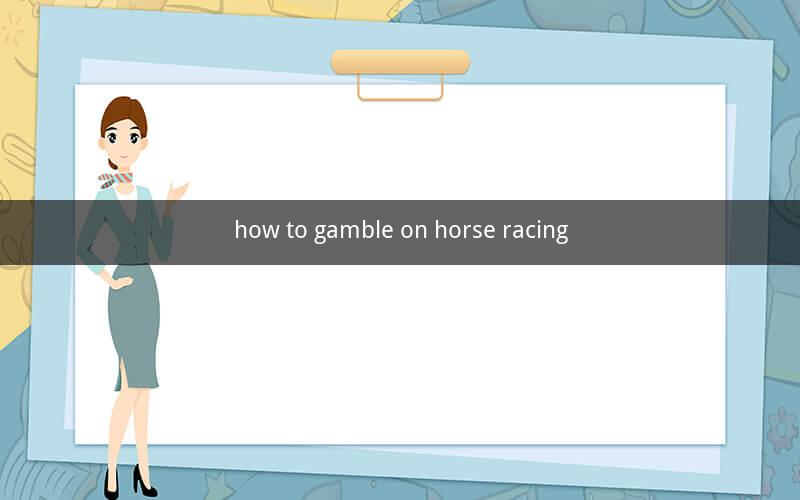
Table of Contents
1. Understanding Horse Racing
2. Types of Horse Racing Bets
3. Choosing the Right Horse and Jockey
4. Analyzing Horse Racing Form
5. Understanding Odds and Payouts
6. Bankroll Management
7. Using Betting Strategies
8. Online Horse Racing Betting
9. Legal Aspects of Gambling on Horse Racing
10. Responsible Gambling
---
1. Understanding Horse Racing
Horse racing is a sport that dates back centuries, with its origins in ancient Greece. It involves thoroughbreds running a set distance on a track, with jockeys riding them. To gamble on horse racing, it's crucial to have a basic understanding of the sport. This includes knowing the different types of races, such as sprints, stakes races, and handicaps.
2. Types of Horse Racing Bets
There are various types of bets you can place on horse racing. The most common ones include:
- Win: Betting on a horse to finish first.
- Place: Betting on a horse to finish first or second.
- Show: Betting on a horse to finish first, second, or third.
- Across the Board: Betting on a horse to win, place, and show.
- Exacta: Betting on two horses to finish first and second in the exact order.
- Trifecta: Betting on three horses to finish first, second, and third in the exact order.
- Superfecta: Betting on four horses to finish first, second, third, and fourth in the exact order.
3. Choosing the Right Horse and Jockey
Selecting the right horse and jockey is key to making informed bets. Consider the following factors:
- Past Performance: Look at the horse's track record, including wins, losses, and finishes.
- Jockey Experience: A jockey's experience can significantly impact a horse's performance.
- Trainer: A reputable trainer can make a big difference in a horse's performance.
- Track Conditions: Some horses perform better on certain tracks due to the surface, weather, or distance.
4. Analyzing Horse Racing Form
Form is an essential aspect of horse racing betting. It involves analyzing a horse's past performances, including speed, stamina, and consistency. You can find form guides in newspapers, online, or at the track itself. Pay attention to the following:
- Speed Ratings: These provide an indication of how fast a horse has run in the past.
- Class: Higher-class races often feature stronger competition.
- Consistency: A horse with consistent performances is often a safer bet.
5. Understanding Odds and Payouts
Odds represent the likelihood of a horse winning. Lower odds mean a horse is favored to win, while higher odds indicate a longer shot. Payouts are determined by the odds and the amount of money wagered. Understanding how odds and payouts work is crucial for making profitable bets.
6. Bankroll Management
Managing your bankroll is vital for long-term success in horse racing betting. Allocate a budget for betting and stick to it. Avoid chasing losses and never bet more than you can afford to lose.
7. Using Betting Strategies
Several betting strategies can help you increase your chances of winning. Some popular strategies include:
- Parlay Betting: Combining multiple bets for a higher payout.
- Betting Against the Public: Contrary to popular opinion, betting against favorites can sometimes be profitable.
- Betting on Long Shots: While risky, betting on long shots can yield significant payouts.
8. Online Horse Racing Betting
Online horse racing betting has become increasingly popular. Many websites offer a variety of betting options, including live streaming of races. When betting online, ensure you choose a reputable site and be aware of any fees or restrictions.
9. Legal Aspects of Gambling on Horse Racing
Gambling on horse racing is legal in many countries, but regulations vary. Always check the legal aspects of gambling in your jurisdiction to avoid any legal issues.
10. Responsible Gambling
Responsible gambling is crucial for a healthy betting experience. Set limits for yourself, take breaks, and seek help if you feel you have a gambling problem.
---
Questions and Answers
1. What is the difference between a win bet and a place bet in horse racing?
- A win bet is a bet on a horse to finish first, while a place bet is a bet on a horse to finish first or second.
2. How can I tell if a horse is well-trained?
- Look for consistent performances, good speed ratings, and a reputable trainer.
3. What is a trifecta bet in horse racing?
- A trifecta bet is a bet on three horses to finish first, second, and third in the exact order.
4. How do odds and payouts work in horse racing betting?
- Odds represent the likelihood of a horse winning, while payouts are determined by the odds and the amount of money wagered.
5. What is bankroll management in horse racing betting?
- Bankroll management involves allocating a budget for betting and sticking to it to avoid financial strain.
6. What are some popular betting strategies in horse racing?
- Popular strategies include parlay betting, betting against the public, and betting on long shots.
7. Is online horse racing betting legal in all countries?
- No, regulations vary by country, so it's important to check the legal aspects of gambling in your jurisdiction.
8. How can I tell if a jockey is experienced?
- Look for a jockey with a long track record of successful rides and consistent performances.
9. What is the importance of analyzing horse racing form?
- Analyzing form helps you make informed bets by considering a horse's past performances, speed, stamina, and consistency.
10. How can I avoid chasing losses in horse racing betting?
- Set limits for yourself, take breaks, and avoid betting more than you can afford to lose.